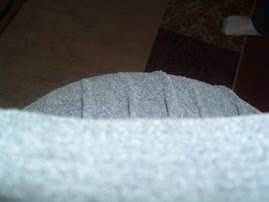Alas, I'm also cheap. Years ago, I decided to take the same concept as inspiration for creating a bill paying (or, as I like to put it positively, wealth management) folder. I stopped using the folder for one reason or another. It may have been packed at the bottom of a box of paperwork during a move. As I investigated ways to streamline in '09, I rediscovered my wealth management folder, and I have to say that I've been pretty pleased so far. To make your own, you will need:
- A simple three-prong folder, binder, or a fancier take on the same theme
- Three top loading heavy-duty sheet protectors
- Five binder dividers with folders
- An ultra-fine dry erase marker
- At least four pieces of card stock for your printer; printed with:
- A 2009 calendar
- Your 2009 Budget
- Your Budget Tracker (One or two pages listing each budget category where you can record flexible expenditures as you make them.)
- Your Monthly Debits (A table of recurring monthly expenses, their due dates, average cost, and column for six months of recording the date paid.)
Step Two: Place the items into the folder in the following order: Calendar, Budget Tracker, Monthly Budget, Monthly Debits, Binder Dividers
Step Three: On each pocket, write "DUE DATE" Beneath it, write the days of the month: 1, 2, 3..." etc. Write three days on each pocket; but four days on the last pocket (28, 29, 30, 31).
Step Four: Label and decorate the front of the folder with "Wealth Management." Make it pretty! On the inside pocket of the folder, you will need to write "Attention," or "Special," or "Supplies." On the back inside pocket, write "File."
Step Five: As bills arrive, open them immediately. Place each bill in the pocket which corresponds with its due date. If the bill is for a donation or other special expense, place it in the front pocket.
Step Six: As you pay bills, mark each bill on your Budget Tracker and your Monthly Debits page, using your dry erase marker. Place each paid bill in the back of your folder.
Step Seven: Each expenditure should be tracked on your Budget Tracker. Use the figures from last month on your Monthly Budget to guide your spending in the following months.
Step Eight: At the end of the month, transfer your values from the Budget Tracker to your Monthly Budget. File the bills at the back of your folder. Look at any paperwork still stored in your front pocket. Erase the Budget Tracker to prepare for next month. You may choose to print out or copy your Monthly Budget for future reference or to track your progress.
Step Nine: At the end of each six-month cycle, reevaluate your budget to make necessary changes. Transfer the values from your Monthly Debits page to a paper document for your records. Edit the Monthly Debits to reflect changes in your monthly cashflow. Replenish any broken or tattered pages.
Step Ten: Feel good; you have kept up on your monthly financial obligations and are able to focus on your long-term financial goals because the daily tasks are now almost automatic. Congratulations! As an added bonus, you can use the pockets to store birthday cards on their perfect send out dates.
Why not use a digital tracking system like Quicken or Money? It will do all these things, but will also produce amazing, attractive reports and synch with your bank account information, too. It's all automatic! That's the problem. Regardless of how automated we become, there is still paperwork that demands management and filing. If you're like me, you feel obligated to "handle" this paperwork somehow, to track, document, and guide your spending. This folder helps me to keep hold of that thin thread of control over my finances. When my online banking offers similar spending software, and all my bills are automatically deducted from my checking account, I'll probably give up my folder. Until then, the system works for me.





No comments:
Post a Comment